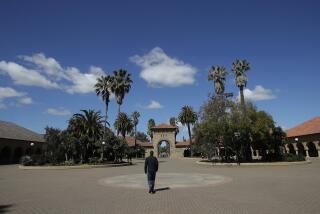Defending college endowments
When members of Congress demand that colleges and universities with larger endowments spend 5% annually to reduce student expenses, anyone facing a tuition bill understandably nods emphatically.
But if the state of the stock market is any indication, the era of hefty annual -- or even positive -- returns for college endowment funds is likely to be over, perhaps for quite some time. It’s a good thing that colleges have been allowed to tend to our resources as needed, not as Congress would demand. Because of that latitude, endowed colleges can now use that money to continue to offer generous financial aid packages for our nation’s best, brightest and neediest students, including those from middle-class families whose parents may have lost jobs recently or seen their nest eggs dwindle.
The fact that careful investment decisions were made during boom times will help see colleges through the rainy days that appear to have arrived. Just last week, hundreds of colleges and universities discovered that some of the funds in their endowments that were thought to be highly liquid and available for expenses, such as payroll, are now inaccessible, at least for the time being. Even some of the best-positioned colleges will now face serious challenges.
Amherst, where I am president, is a highly selective liberal arts college in Massachusetts, with an enrollment of just under 1,700. It was founded in 1821 to serve indigent students “of piety and talents.” Since then, the college has maintained its commitment to accessibility and affordability through many downturns, the current one being no exception. Already, our financial aid office is responding to economic turbulence by revising aid grants for students affected by economic hardship. Our financial aid budget has jumped up just this year by $4 million. And if we have to eat into our endowment beyond the 5% level that Sen. Charles E. Grassley talks about, we will.
But it is something else entirely for Congress to set a minimum spending rate for colleges’ endowment funds. That is unnecessary and would be counterproductive, putting institutions with slightly smaller endowments at tremendous risk of burning through their funds during a downturn, just when we need more great colleges to prepare our workforce.
In addition, the financial benefit would be minimal. Colleges and universities spent, on average, 4.6% of their endowment funds in 2007, according to the National Assn. of College and University Business Officers. With $411.2 billion collectively in those funds, that works out to about $18.9 billion being spent on operating expenses, which includes student aid. Forcing the spending rate up to 5% would generate an additional $1.6 billion. Charles Miller, who recently chaired the secretary of Education’s Commission on the Future of Higher Education, rightly pointed out that compared with the annual $350 billion that’s being spent on higher education from all sources -- parents, students, state and federal government and endowments themselves -- this is “tinkering with the decimals.” Meanwhile, the wealthiest schools -- where 5% of an endowment could total nearly $1 billion -- may feel pressed to stop charging any tuition to their wealthiest students. Is that how we want our educational resources spent?
Like Congress, and as a parent, I am concerned about the price of tuition. We all recognize that middle- and lower-income families are scared off by the sticker price of private colleges. Despite the best efforts of such schools to trumpet their ample financial aid resources, which endowments help make possible, many students and parents of modest means don’t realize how significant their tuition discount will be.
Last year, for example, Amherst provided more than $26 million in scholarship aid to more than half of the student body; the average scholarship package was more than $30,000. Beginning in the 2008-09 school year, undergraduates are no longer are required to take out student loans as part of their financial aid awards; loans have been replaced by grants from us. Amherst is among only a handful of colleges and universities in the country that does not require students to take on such debt to pay for an education. And, thanks to our endowment, we will maintain that commitment despite the current economic turmoil.
Not only financial aid students benefit from an endowment. At Amherst, the average student is subsidized by $37,000, because the actual cost of educating a student for one year is about $80,000. Our sticker price is just over half of that, though most students don’t pay that full price, and many pay nothing at all. We aim to be the most selective and the most diverse college. Because a quarter of our students come from low-income backgrounds, the endowment makes that possible.
In short, healthy endowments -- and flexibility in how and when we tap them -- allow colleges and universities to ensure financial aid and ensure the superior quality of the education we provide. Amherst and other colleges are dedicated to making college more affordable, and we look forward to working with Congress on ways to do that. But whatever steps are taken should not compromise the excellence of the nation’s higher education system, perhaps the one industry sector remaining in which the United States remains the global leader.
Anthony W. Marx is the president of Amherst College.






